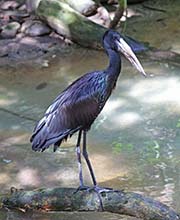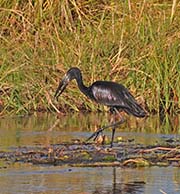African Openbill - Anastomus lamelligerus
| Length | |
| Clutch Size | |
| Chicks at birth | |
| IUCN Conservation Status | |
Continents: |
The African Openbill is a small stork that is found in sub-Saharan Africa. The plumage is black with purple and green iridescent highlights. Their iris is brown with a yellow inner ring. The most unique feature is the large brownish bill with a gap that is specifically designed to remove molluscs from their shells. Legs and feet are black with gray eyes. Both sexes are similar in both size and coloration.
Even though the population of African Openbills seem to be decreasing, they are listed by the IUCN as a bird of 'Least Concern due to the current population size and because they are found throughout sub-Saharan African. They are listed as 'Near-threatened' in South Africa due to the use of pesticides to control mosquito population and habitat loss.
Diet: African Openbills can be found feeding singly or in large groups over 7,000. They mostly eat aquatic invertebrates such as snails and bivalves. They will also eat frogs, crabs, worms, fish and insects.
Their bill has adapted to extract snails from their shells. The Openbill uses its upper mandible (upper bill) to steady the snail against the ground and uses the sharp lower mandible to slip under the bony shield protecting the snail and cutting the muscle holding the snail in place. The body of the snail is then extracted and eaten. This technique works for mussels and other bi-valves but not quite as efficiently.
Courtship: African Openbills breed during the rainy season when snails are most readily available. Courtship consists of the male picking a nest site and performing 'displays' on it. Attracted females will try to approach the male's nest site but the male will initially drive them away, sometimes violently. Eventually he will copulate with her.
Nesting: African Openbills are colonial nesters and will nest with other species. Both sexes build the nest which consists of a small platform of sticks and twigs and lined with leaves, grass, etc. The nest is built in trees and bushes. Nesting may only occur in years when local food supplies are plentiful. Egg-laying season is from August-May and usually 2-3 eggs are laid.
Habitat and Range: African Openbills are found in wetlands, flood plains, rivers, dams and lagoons that have a lot of aquatic molluscs. The range includes most of sub-Saharan Africa.
Vocalization: Like other storks, the Openbill creates various clicks and clacks with its bill. They also produce loud croaks and honks.
Plumage/Molt They don't have alternate plumage.
Migration: This species is an intra-African trans-equatorial migrant making movements that are triggered by the rains. It migrates in flocks.
Tongue/feet:Bibliography:
- http://en.wikipedia.org The Free Encyclopedia, Accessed July, 2012
- http://birdlife.org BirdLife International, Accessed July, 2012
- http://www.botswanatourism.co.bw Botswana's Official Tourism Site, Accessed July, 2012
- http://www.kenyabirds.org.uk/ Kenya Birds, Accessed July, 2012
- http://www.biodiversityexplorer.org/birds/fringillidae/crithagra_mozambicus.htm Biodiversity Explorer - The web of life in Southern Africa, Accessed July, 2012
- Maclean, Gordon Linday, Robert's Birds of Southern Africa,John Voelcker Bird Book Fund, 1985








